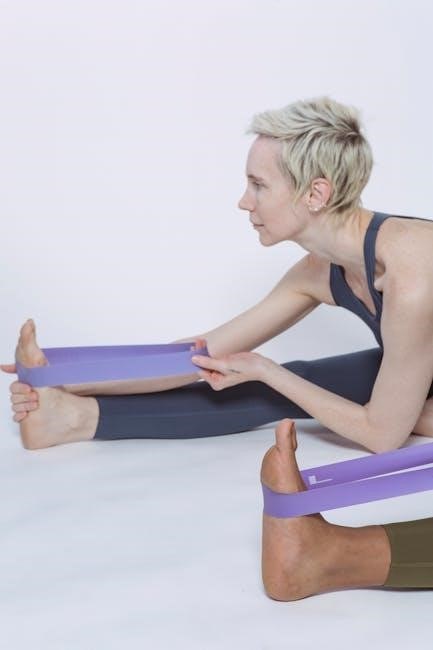
Rotator cuff band exercises are effective for strengthening shoulder muscles and improving flexibility. Resistance bands provide controlled resistance, making them ideal for rehabilitation and home workouts.
Importance of Rotator Cuff Health
A healthy rotator cuff is essential for shoulder stability, mobility, and preventing injuries. The rotator cuff consists of four muscles and tendons that support the shoulder joint, enabling smooth movement and protecting it from strain. Weakness or damage to the rotator cuff can lead to pain, limited range of motion, and difficulty performing daily activities or sports. Strengthening the rotator cuff through targeted exercises, such as those using resistance bands, is crucial for maintaining shoulder health and preventing common issues like impingement or tears. A strong rotator cuff also enhances overall athletic performance and reduces the risk of chronic shoulder problems. Prioritizing rotator cuff health ensures long-term shoulder functionality and quality of life.

Benefits of Using Resistance Bands
Resistance bands offer a versatile and effective way to strengthen the rotator cuff. They are lightweight, portable, and cost-effective, making them ideal for home workouts or rehabilitation. Unlike heavy weights, resistance bands provide controlled tension, reducing the risk of overuse injuries. They also allow for precise targeting of specific muscles, ensuring focused strengthening of the rotator cuff. Additionally, resistance bands enable progressive overload, meaning you can increase difficulty as strength improves; Their flexibility makes them suitable for varying fitness levels, from rehabilitation to advanced training. This adaptability ensures that resistance bands are a practical and efficient tool for achieving strong, healthy shoulders.
Key Principles for Effective Rotator Cuff Strengthening
Effective rotator cuff strengthening requires proper form and posture to ensure targeted muscle engagement. Movements should be controlled and deliberate, avoiding jerky or bouncy actions. Start with lower resistance and gradually increase as strength improves, allowing muscles to adapt without overloading. Consistency is crucial, with exercises performed 3-4 times weekly. Focus on slow, precise repetitions to maximize muscle activation. Avoid compensatory movements, such as shrugging shoulders, to maintain proper technique. Pain or discomfort during exercises should prompt immediate cessation or modification. Breathing naturally and maintaining a neutral spine further enhance the effectiveness of rotator cuff strengthening routines.

Essential Rotator Cuff Band Exercises
Internal and external rotations, rows, and scapular punches are fundamental exercises for strengthening the rotator cuff. They improve shoulder stability and are ideal for rehabilitation and strength enhancement.
Internal Rotation with Arm Adducted to Side
This exercise targets the internal rotators of the rotator cuff, enhancing shoulder stability. Anchor the band at waist level and hold both ends with your arms at your sides and elbows bent at 90 degrees. Keeping your upper arms still, pull the band toward your body by rotating your shoulders inward. Focus on slow, controlled movements to engage the muscles effectively. Perform 3 sets of 10 repetitions, gradually increasing resistance as strength improves. Proper form is crucial to avoid injury and maximize benefits for shoulder health and mobility.
External Rotation with Arm Adducted to Side
External rotation with the arm adducted to the side is a fundamental exercise for strengthening the external rotators of the rotator cuff. Anchor the resistance band at waist level and hold both ends with your arms at your sides, elbows bent at 90 degrees. Maintain proper posture by keeping your shoulder blades down and back. Slowly pull the band outward, rotating your shoulders without moving your elbows. Focus on controlled movements to effectively engage the muscles. Perform 3 sets of 10 repetitions, increasing resistance as strength improves. This exercise enhances shoulder stability and mobility, making it ideal for both rehabilitation and general shoulder health.
Rows for Rotator Cuff Strengthening
Rows are an effective exercise for strengthening the rotator cuff and surrounding muscles. To perform, anchor the resistance band at chest height and stand facing it. Hold both ends of the band with your arms extended, elbows slightly bent, and palms facing down. Engage your core and pull the band towards your chest, squeezing your shoulder blades together. Maintain controlled movements to avoid jerking or shrugging your shoulders. Focus on slow, deliberate pulls to maximize muscle engagement. Complete 3 sets of 10 repetitions, adjusting the resistance as needed. This exercise targets the supraspinatus, infraspinatus, and teres minor muscles, improving shoulder stability and overall rotator cuff function.
Scapular Punches or Press Up

Scapular punches, or press-ups, target the rotator cuff and scapular stabilizers. Anchor the resistance band at shoulder height and hold both ends with your arms extended. Engage your core and press the band forward, extending your arms while squeezing your shoulder blades together. Avoid shrugging your shoulders; focus on controlled, smooth movements. Inhale as you press forward and exhale as you return to the starting position. Perform 3 sets of 10 repetitions, adjusting resistance as strength improves. This exercise enhances scapular mobility and strengthens the supraspinatus and deltoid muscles, improving overall shoulder stability and reducing injury risk.
Advanced Rotator Cuff Band Exercises
Advanced exercises like shoulder scaption and Theraband diagonal-down pulls challenge the rotator cuff further, enhancing strength and stability. These movements require precise control and form for optimal results.
Shoulder Scaption
Shoulder scaption targets the supraspinatus and deltoid muscles, enhancing rotator cuff strength and stability. Stand on the resistance band with your feet shoulder-width apart. Hold the ends of the band and pull it upward and slightly forward, keeping your elbows slightly bent. Avoid shrugging your shoulders. Perform the movement slowly and control the return to the starting position. This exercise improves shoulder mobility and reduces injury risk. Use a mirror to monitor form and ensure proper alignment. Start with lighter resistance and gradually increase as strength improves. Focus on smooth, controlled movements to maximize effectiveness and prevent strain.
Theraband Diagonal-Down Pulls
Theraband diagonal-down pulls are an advanced exercise targeting the rotator cuff muscles, particularly the supraspinatus and infraspinatus. Stand facing away from the anchor point with the Theraband attached behind you at shoulder height. Hold the ends of the band and pull it diagonally downward, keeping your elbows slightly bent. Focus on controlled movements to avoid using momentum. This exercise strengthens the rotator cuff, improving shoulder stability and reducing injury risk. Start with lighter resistance and progress as strength improves. Maintain proper form by keeping your shoulders relaxed and avoiding shrugging. Perform 3 sets of 10-12 repetitions for optimal results.

Exercise Progression and Safety Tips
Begin with lighter resistance and progress gradually. Maintain proper form to avoid injury. Stop if discomfort occurs and modify as needed for safe, effective workouts.
How to Increase Resistance Safely
When increasing resistance, start with small increments by using a thicker band or adding layers. Ensure proper form is maintained throughout. Gradually increase repetitions or sets as strength improves. Avoid sudden jumps in resistance to prevent overloading the muscles. Always warm up before exercises and cool down afterward to maintain flexibility and reduce injury risk. Consistency and patience are key to building strength without compromising safety.
Proper Form and Posture
Maintaining proper form and posture is crucial for effective rotator cuff strengthening. Keep your shoulders relaxed and down, avoiding shrugging or compensatory movements. Engage your core to stabilize your body and ensure controlled movements. During exercises, focus on slow, deliberate actions to maximize muscle activation and minimize strain. Avoid using momentum or jerky movements, as this can lead to injury or reduced effectiveness. Keep your chest upright and maintain a neutral spine throughout. If discomfort occurs, adjust your posture or modify the exercise. Proper alignment ensures the rotator cuff muscles are targeted correctly, promoting strength and stability without compromising joint health.
When to Stop or Modify Exercises
If you experience sharp pain, numbness, or tingling during or after exercises, stop immediately and consult a healthcare professional. Mild discomfort is common, but severe pain indicates a need to modify. If proper form cannot be maintained due to fatigue or limited mobility, reduce resistance or adjust the range of motion. Avoid pushing through pain, as this may worsen inflammation or injury. Modify exercises by decreasing the intensity or switching to a lower-resistance band. Rest and recovery are critical; do not continue if symptoms persist. Prioritize joint stability and muscle activation to ensure safe progression. Always consult a therapist or trainer for personalized adjustments.
Rotator cuff band exercises are a highly effective way to strengthen shoulder muscles, improve mobility, and prevent injuries. Consistency and proper form are key to achieving lasting benefits. These exercises are suitable for both rehabilitation and general fitness, offering versatility and convenience. Always prioritize gradual progression and seek professional guidance if needed. Regular practice can enhance overall shoulder health, reducing the risk of future discomfort. By incorporating these exercises into your routine, you can maintain strong, stable shoulders for years to come. Remember, patience and adherence to proper techniques will yield the best results and ensure long-term shoulder wellness.